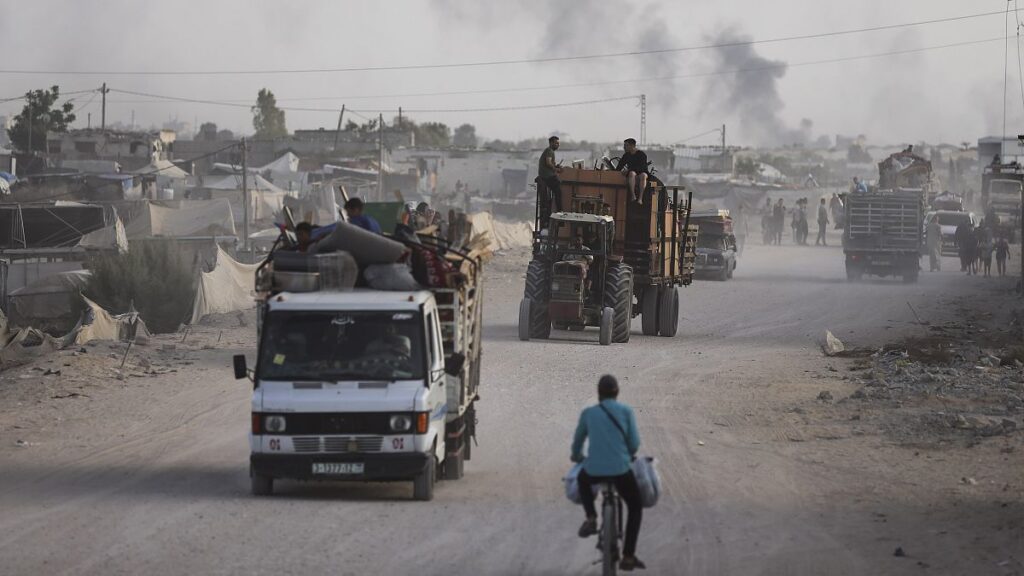Most of them were sheltering in tents outside the town of Rafah in the southern Gaza Strip. This is the second such attack against civilians.
Artillery fire and Israeli airstrikes killed at least 37 people, most sheltered in tentsoutside the city of Rafah on the night of Tuesday to Wednesday, striking the same area where strikes sparked a deadly fire a few days earlier in a camp for displaced Palestiniansaccording to witnesses, emergency workers and hospital officials.
Attack on tent camp sparks international outrageincluding some of Israel’s closest allies, in the face of the expansion of the military offensive in Rafah.
Sign of Israel’s growing isolation on the international sceneSpain, Norway and Ireland have officially recognized a Palestinian stateTuesday.
The Israeli military suggested that Sunday’s fire in the tent camp could have been caused by secondary explosionsperhaps from Palestinian militant weapons.
Military spokesman Rear Admiral Daniel Hagari said the cause of the fire was still under investigationbut that the Israeli munitions used – which, according to the army, were aimed at a position where two important Hamas militants were located – were too small to be the cause of the fire.
The strike or subsequent fire may also have ignited fuel, cooking gas canisters or other materials in the camp.
The fire killed 45 Palestinians, according to the count of Gaza health authorities. Israeli Prime Minister Benjamin Netanyahu said the fire was the result of a ” tragic accident “.
The Israeli assault on Rafah, launched on May 6, pushed more than a million people flee the city, the United Nations agency responsible for aiding Palestinian refugees said on Tuesday. Most of them had already been displaced several times during the war between Israel and Hamas which lasted almost eight months. Families are now scattered in makeshift tent camps and other war-ravaged areas.
“It was a night of horror”
The strikes of recent days have affected areas west of Rafah, where the army had not ordered the evacuation of civilians. Israeli ground troops and tanks operated in eastern Rafah, in the city’s central neighborhoods and along the Gaza-Egypt border.
Shelling hit the western Rafah neighborhood of Tel al-Sultan late Monday and early Tuesday, killing at least 16 peopleaccording to the Palestinian Civil Defense and the Palestinian Red Crescent. Seven of the dead were in tents next to a UN facility, about 200 meters from where Sunday’s shootings took place.
“ It was a night of horror »said Abdel-Rahman Abu Ismail, a Palestinian from Gaza City who has taken refuge in Tel al-Sultan since December.
He stated that he had heard “ constant noises » explosions overnight and into Tuesday, with fighter jets and drones flying overhead.
He also added that it reminded him of the Israeli invasion of his Shijaiyah neighborhood in Gaza City, where Israel launched an intensive bombing campaign before sending in ground forces in late 2023. We’ve seen this before “, did he declare.
The United States and other allies of Israel have warned of a full offensive in the citythe Biden administration believing that it would cross a “ Red line » and refusing to provide offensive weapons for such an enterprise.
On Tuesday, US State Department spokesperson Matthew Miller did not indicate that the administration considered Israel to have crossed one of the red lines in Rafah, asserting that the offensive was of a magnitude “ very different » compared to attacks on other population centers in Gaza.
The International Court of Justice ordered last week in the case of South Africa accuses Israel of committing genocide against the Palestinians of Gaza to “immediately stop its military offensive”.
A proposed UN Security Council resolution demanding an end to the fighting in Rafah was tabled by Algeria on Tuesday, with the intention of putting it to a vote this week.
The United States opposed their veto of numerous ceasefire resolutions in Gaza.

